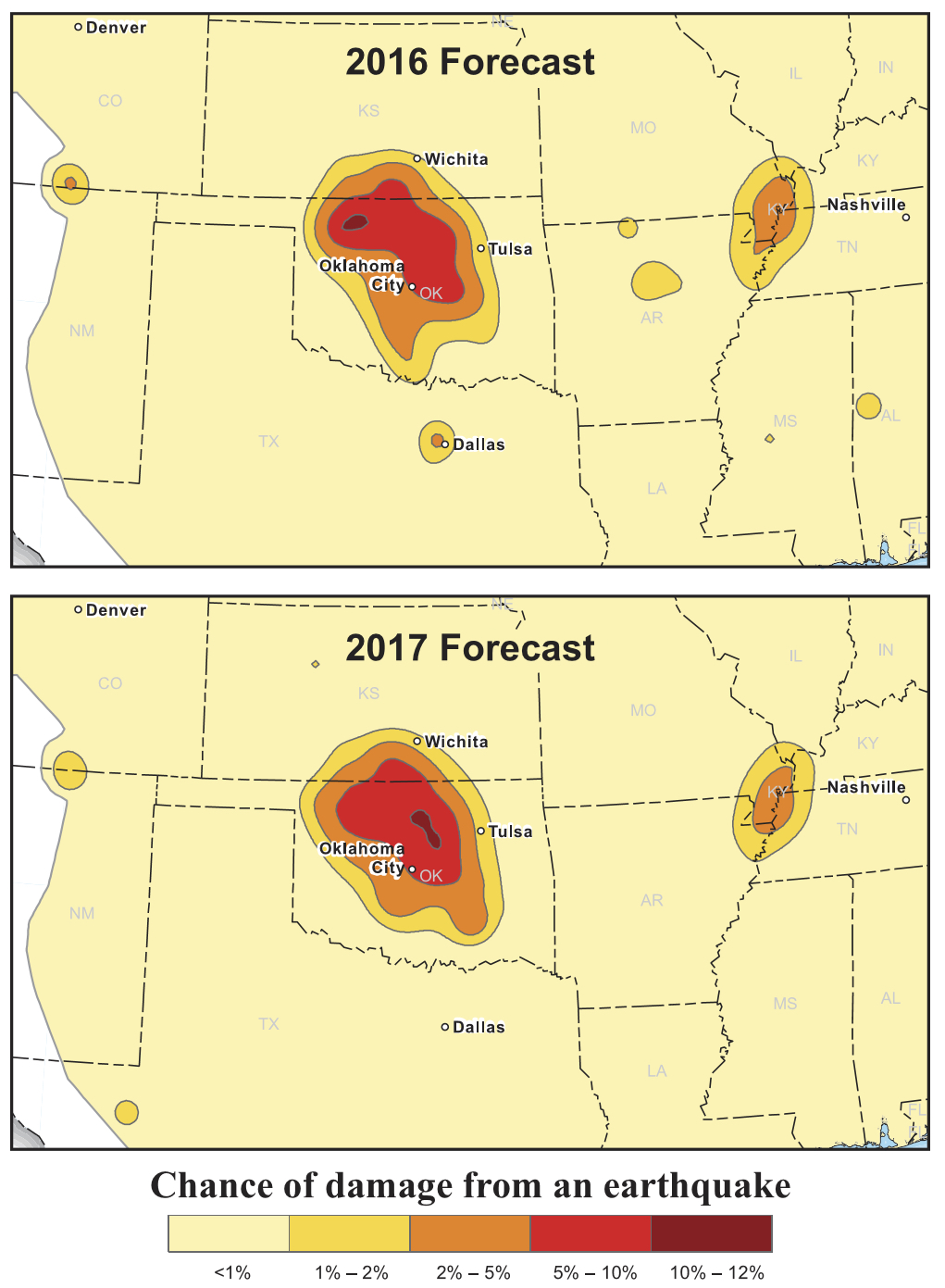By David Jacobson, Temblor
Check your seismic hazard rank

In a journal article published yesterday, the USGS released a 2017 earthquake forecast for the central and eastern United States. This new forecast considers not only natural earthquakes, but man-made ones as well. This is of particular interest to places like Oklahoma, where wastewater injection has been shown to lead to an increase in seismicity. By incorporating induced seismicity into a seismic hazard model, parts of a state like Oklahoma, has the same earthquake threat as California.
When normal seismic hazard models are made, only natural earthquakes are considered, and the assessments are for long periods (i.e., 50-years) of time. However, in regions where induced earthquakes are possible, seismicity can change extremely rapidly, in some cases, yearly. For example, in Oklahoma between 1980 and 2000, the state averaged two M=2.7+ earthquakes per year. Last year, there were 2500. Furthermore, recent man-made earthquakes such as the 2016 Pawnee and Cushing, Oklahoma quakes, caused damage, signaling they must be included in hazard assessments. This is also vital because such assessments are applied to building codes, earthquake insurance, and other public policies.

This is only the second earthquake forecast for the central and eastern United States that includes the effects of man-made earthquakes. Therefore, the process is still developing. To create the 2017 forecast, the same methodology used to make the 2016 was used, but the earthquake catalog from 2016 was incorporated to see how last year’s forecast compared to observations. Perhaps due to lower oil prices or the reduction in wastewater injection, there were fewer earthquakes in Oklahoma last year than there were in 2015. Because the number of M=2.7+ earthquakes is used to forecast the rate of future events, the 2017 hazard forecast is lower than it was in 2016.

Despite the fact that the hazard forecast is lower, it would probably shock most people to learn that the likelihood of a damaging earthquake in 2017 in Oklahoma City is higher than it is in San Francisco, Oakland, or Los Angeles. Based on the results of this new study, the likelihood in Oklahoma City is 5-10%, while in the three California cities, it is 2-5%. This means that over 3 million people live in an area of significant seismic hazard where much of it is not natural. Therefore, understanding these risks is extremely important.
While this likelihood may seem high, the developers of the model stress that the uncertainties involved in forecasting induced events is extremely high. This is evident as changes in industrial activity between 2015 and 2016 appear to have dramatically changed the region’s seismicity. Factors such as this are not included in the forecast. Nonetheless, this 2017 forecasted hazard is significantly higher than the 2014 National Seismic Hazard Model. This seems apt as the 2014 model does not include the effects of induced earthquakes, which until recently were not known to be able to cause damage in this portion of the country. Therefore, they should be considered, not discounted.
Reference
Mark D. Petersen, Charles S. Mueller, Morgan P. Moschetti, Susan M. Hoover, Allison M. Shumway, Daniel E. McNamara, Robert A. Williams, Andrea L. Llenos, William L. Ellsworth, Andrew J. Michael, Justin L. Rubinstein, Arthur F. McGarr, and Kenneth S. Rukstales, 2017 One-Year Seismic-Hazard Forecast for the Central and Eastern United States from Induced and Natural Earthquakes, Seismological Research Letters, March 2017; 88 (2A), DOI: 10.1785/0220170005
- Earthquake science illuminates landslide behavior - June 13, 2025
- Destruction and Transformation: Lessons learned from the 2015 Gorkha, Nepal, earthquake - April 25, 2025
- Knock, knock, knocking on your door – the Julian earthquake in southern California issues reminder to be prepared - April 24, 2025
